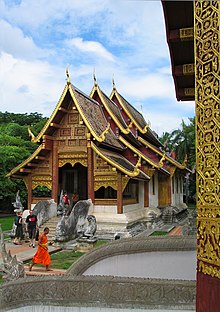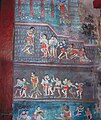Wat Phra Singh

Wat Phra Singh (full name: Wat Phra Singh Woramahawihan - Thai วัด พระ สิงห์ วรมหาวิหาร , RTGS wat phra sing woramaha wihan ) is a Buddhist temple complex ( Wat ) in Chiang Mai , northern Thailand . It is a first class royal temple .
location
Wat Phra Singh is west of the center in the old town of Chiang Mai. Its main portal, guarded by stone lions, is at the end of Chiang Mai's main street, Ratcha Damnoen Road, which leads from here due east through the central Tha Phae city gate down to the Mae Nam Ping ( Ping River ).
meaning
The temple gets its supraregional importance through the Phra Phuttha Sihing, a Buddha statue , the exact origin of which is uncertain. Legend has it that it resembles the "lion of the Shakyas", a lost statue from the Mahabodhi temple in Bodhgaya in India. It is said to have reached Ligor (today's Nakhon Si Thammarat ) via Sri Lanka , from there to Ayutthaya before being brought to Chiang Mai. Today there are a total of three statues in Thailand that are said to be the Phra Sihing. Next to the Phra Phuttha Sihing of Wat Phra Singh in Chiang Mai there is a statue in Wat Phra Mahathat in Nakhon Si Thammarat and another in the Buddhai Sawan Chapel of the Bangkok National Museum .
The head of the statue is said to have been stolen in 1920, so only a replica of the head may be seen today.
Every year for the Songkran Festival, Phra Sihing is brought out of the Wihan and carried in a magnificent procession through the streets of the city, where the faithful pour water on him to pay homage to him.
In Thai popular belief, Wat Phra Singh is associated with the Chinese zodiac sign of the dragon. Those born in the year of the dragon therefore like to make a pilgrimage here.
history
King Pha Yu founded Wat Phra Singh in 1345 by building a chedi to bury the ashes of his father, King Kham Fu . A few years later a Wihan and other buildings were added. The monastery was then given the name "Wat Lichiang". During restoration work in 1925, three urns were discovered in a small chedi, possibly containing the royal ashes. Since then, however, the urns have not been found.
The temple was named "Wat Phra Singh" in 1367 when the famous Buddha statue of Phra Sihing was erected here. In the 18th century, as a result of the Burmese occupation of the city, the temple was abandoned and left to decay until King Kawila came to power in 1782 . The king had the ubosot rebuilt and the chedis expanded. His two successors built the Wihan Lai Kham and the elegant library ( Hor Trai ) .
The famous monk Khru Ba Sri Wichai organized the renovation of the entire temple in the 1920s . Most of the buildings received another renovation in 2002, with new gold leaf applied and the stucco decorations renewed.
Attractions
- Wihan Luang - architecturally rather uninteresting building, the original Wihan was replaced by the current building in 1925.
- Wihan Lai Kham - this building is the main attraction of the temple, an example of the classic Lanna architecture. It was built around 1345 to house the Phra Sihing statue that can still be seen here today. The name refers to the fine drawings in gold on the gable boards ( tympanum ). The roof, which is drawn down low, has three levels , and stucco decorations can be seen in the portico above the entrance doors.
- Ubosot - built in 1806, it has porticos in front and behind and a three-tier roof. Here, too, the gable boards are richly decorated. Inside there is a finely structured, gilded Ku - a kind of tower-shaped altar.
- Hor Trai - just like the Wihan Lai Kham, the Hor Trai (library) is an example of classic Lanna architecture. It is said to have been built in 1477 during the reign of King Tilokarat , renovations took place in 1867, 1920 and 2002. The small wooden building with its three-tiered roof stands on a high brick base that is richly decorated with stucco. A steep staircase, the railing of which is formed by Nagas and Makaras , leads up on the east side. The gable boards of the portico are covered with fine wood carvings.
- Chedi supported by elephants - often enlarged since it was built in 1345. The golden, bell-shaped chedi stands on a high square base, from the sides of which protrude the front parts of elephants decorated with stucco.
Impressions
literature
- Michael Freeman: Lanna - Thailand's Northern Kingdom . River Books, Bangkok 2001, ISBN 0-500-97602-3
- Clarence Aasen: Architecture of Siam . Oxford University Press 1998, ISBN 983-56-0027-9
- Carol Stratton: Buddhist Sculpture of Northern Thailand . Silkworm Books, Chiang Mai 2004, ISBN 1-932476-09-1
Web links
Coordinates: 18 ° 47 ′ 19 ″ N , 98 ° 58 ′ 53 ″ E







